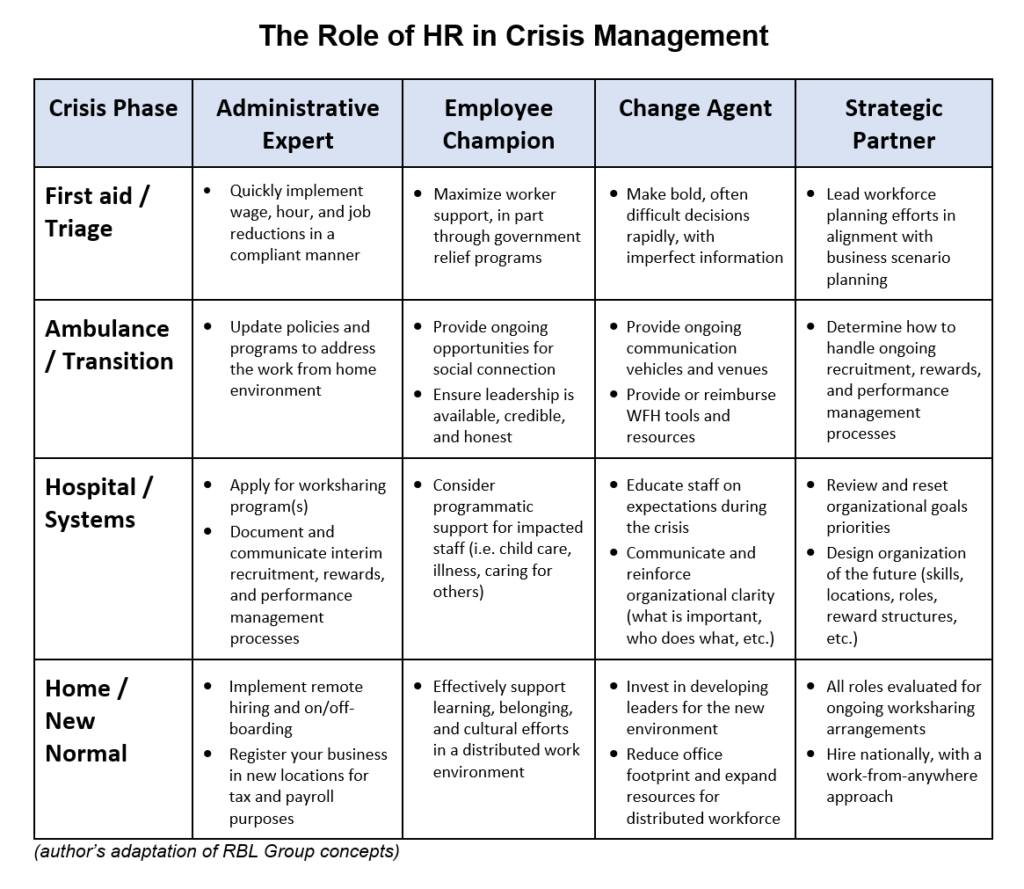Can “good” HR be a strategic advantage in a crisis?
Through the largest and longest bull market in history, many business leaders continued to dismiss the human resources (HR) function as an operational, and largely administrative function. HR’s activities can appear to be – and often are – disconnected from the “real work” of an organization. But effective HR leadership is so much more, and can be a strategic advantage as businesses deal with the COVID pandemic. Let’s unpeel the several roles of HR to better understand how it can contribute.
ADMINISTRATIVE EXPERT
HR is generally the undisputed owner (with support from legal) of internal operational processes such as employment policy administration, payroll & benefits delivery, employment recordkeeping, and employment-related compliance. While the effectiveness and efficiency of these processes can have an impact on a business, this is largely a tactical, administrative role which rarely delivers differentiated value to a business – unless (or until) something goes horribly wrong.
However, in today’s rapidly changing regulatory environment administrative experts are sorely needed. This role is helping employers make sense of often ambiguous employment compliance issues related to worker safety, medical privacy, disabilities, accommodations, leaves, etc. Administrative Experts are also deciphering how workers and businesses can take advantage of the many complex relief programs sponsored by various government entities.
EMPLOYEE CHAMPION
During the escalating “war for talent” over the past dozen years, many leaders devoted attention to worker attraction, retention, and engagement efforts. HR staff has been increasingly asked to advocate for the “voice of the employee”, ensuring that worker engagement is maximized and the organization’s employment brand compares favorably to that of peers – with goals of making it easier to attract qualified candidates, minimizing voluntary worker attrition, and reducing employment-related conflicts. The role of Employee Champion has been embraced by many HR professionals, often attracting advocates for humanistic ideals and promoting social and society benefits beyond basic economic outcomes of the organization.
During the pandemic, Employee Champions are shaping workforce policy and communications, and encouraging companies to take care of their workers. Their organizations are providing valuable support and stability to their workers – financial certainly, but also social, emotional (morale / engagement), as well as mental well-being support. The role of the Employee Champion enhances the brand and reputation of an organization, and can increase worker commitment, particularly during challenging times. These two roles (Administrative Expert & Employee Champion) are generally well-known and well-represented in the function. However, these roles account for only a small portion of the impact that HR practices have on a business. In David Ulrich’s book, HR Champions, he identified 4 key roles that Human Resources professionals play:
David Ulrich’s 4 Roles of Human Resources Model

CHANGE AGENT
We are witnessing the rise of HR’s role as a change agent during the pandemic. HR professionals are helping their organizations sustain their organization’s performance and assure its future performance. This includes enabling people to work effectively as they plan, implement, and experience change – as well as increasing people’s ability to manage future change. Change agents diagnose problems, build strong relationships with their (internal) clients, ensure that an organizational vision is clearly articulated, set an agenda for leadership, solve problems, and implement plans to achieve change goals.
During the pandemic, change agents are intensifying their focus on internal communications and architecting policies and processes to help their businesses adapt to the work from home environment. Their past efforts in building trust, strengthening leadership, and instilling strong processes are now paying off by increasing the capability of their organizations to handle change with less disruption. Harvard Business Review refers to that capability as “change resilience”.
STRATEGIC PARTNER
A major differentiator comes through the role of the strategic partner. In this role, HR defines and aligns the underlying model of the company’s architecture. A company’s architecture is essentially the organization’s way of doing business. McKinsey created the 7-S framework, which distinguishes seven components of a company’s architecture: strategy, structure, systems, staff, style, skills, and shared values. Jay Galbraith’s star model identifies five essential organizational components: strategy, structure, rewards, processes, and people. To define and align an organization’s architecture, a strategic partner must possess an understanding of the business’ market and brand positioning, appreciation for the senior-most leader’s style, awareness of organizational effectiveness principles, and a measure of design-thinking creativity. Ultimately, the value is drawing a thread through all of these elements, providing consistency and clarity to an organization’s operating model.
During (and following) a crisis, fear and uncertainty can poison an organization. In the absence of information, we humans tend to assume the worst. By reaffirming elements that will continue or thoughtfully pivoting as appropriate, a strategic partner can help bring needed clarity and stability to an organization. Patrick Lencioni describes the process of creating, communicating, and reinforcing clarity to drive organizational health. In a crisis like the COVID-19 pandemic, that stability and clear direction is more important than ever.
THE 4 ROLES OF HR IN THE 4 PHASES OF CRISIS
RBL Group describes 4 phases of a crisis in relation to an accident:

Following is an example of how each of the 4 roles for HR could be represented during this crisis:

When HR fully embraces each of the 4 roles, HR serves as the leader of all things related to internal strategy, planning, operations, and communications. With labor costs (including wages, benefits, payroll taxes) comprising >70% of total costs of most businesses (more when including indirect items such as recruitment, training, facilities, programs & events, facilities, equipment, etc.), this is a function that clearly has a tremendous impact on the bottom line. With its responsibilities as definer, clarifier, communicator, and aligner, it also has as major potential to drive the business forward.
At its most successful, and perhaps at its most visible during a crisis, this is the function that will help organizations quickly stabilize their team, adjust to new business circumstances, reset or reinforce priorities, and align structures to ensure the right activities have a clear path to execution. While HR continues to process payroll and ensure benefits are delivered, if that is the primary focus of your HR function’s attention, your organization is probably suffering for it.
By no means do we intend to suggest that the Strategic Partner and Change Agent are more valuable than the Administrative Expert and Employee Champion roles. Rather, they are all essential. Unfortunately, many organizations have hired and resourced HR teams to perform only the Administrative Expert and perhaps the Employee Champion functions, without fully understanding the opportunities that are lost by failing to invest in more strategic and future-focused capabilities of the function. If you don’t currently have an HR team that is filling all of these roles, ask yourself why. Perhaps there is a resourcing issue or a skill gap. Perhaps some part of the strategic roles have been delegated to a duplicative “shadow” group to perform under-attended activities. It is never too late to invest in building organizational capabilities – even during a crisis. CEOs, take full advantage of this crisis to broaden your understanding and reset your expectations for the role. HR practices are the secret sauce, connective tissue, and strategic differentiator of most organizations. During this crisis, show appreciation for those who have risen to the occasion, and consider investing in the function if you see opportunities for improvement.
Extraordinary times call for extraordinary leadership: InterimExecs RED Team is an elite group of CHROs, CEOs, CFOs, and CIOs who help organizations through turnaround, growth, or absence of leadership. Learn more about InterimExecs RED Team at www.interimexecs.com/red-team or call +1 (847) 849-2800.
More Resources:
*Strategy Focused CEOs See Growth and Opportunity Even in Crisis
*Surviving Zero Revenue: Thoughts from a Turnaround CEO







